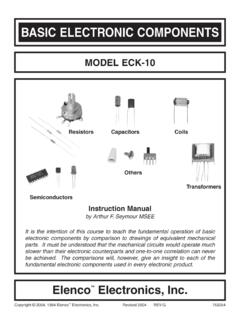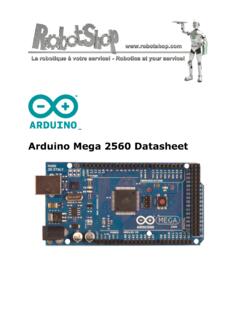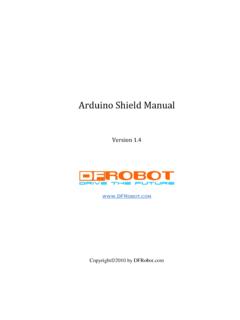Transcription of History of Robotics: Timeline
1 History of Robotics: Timeline This History of robotics is intertwined with the histories of technology, science and the basic principle of progress. Technology used in computing, electricity, even pneumatics and hydraulics can all be considered a part of the History of robotics. The Timeline presented is therefore far from complete. Robotics currently represents one of mankind s greatest accomplishments and is the single greatest attempt of mankind to produce an artificial, sentient being. It is only in recent years that manufacturers are making robotics increasingly available and attainable to the general public.
2 The focus of this Timeline is to provide the reader with a general overview of robotics (with a focus more on mobile robots) and to give an appreciation for the inventors and innovators in this field who have helped robotics to become what it is today. RobotShop Distribution Inc., 2008 Greek Times Some historians affirm that Talos, a giant creature written about in ancient greek literature, was a creature (either a man or a bull) made of bronze, given by Zeus to Europa. [6] According to one version of the myths he was created in Sardinia by Hephaestus on Zeus' command, who gave him to the Cretan king Minos.
3 In another version Talos came to Crete with Zeus to watch over his love Europa, and Minos received him as a gift from her. There are suppositions that his name Talos in the old Cretan language meant the "Sun" and that Zeus was known in Crete by the similar name of Zeus Tallaios. Since Talos was a bronze man, his blood was lead, which they believed was a divine fluid (ichor), identical to that what runs in the veins of the gods. Talos' single vein was leading from his neck through his body to one of his heels, which was closed by a bronze nail or a bronze peg or a pin.
4 [13] ~77-100BC In 1901, between the islands of Crete and Kythera, a diver found the remnants of what might only be considered a mechanical computer. The device is a complex mix of gears which most likely calculated the position of the sun, moon or other celestial bodies.[7] The device dates back 2000 years and is considered to be of Greek origin and was given the name The Antikythera Device . ~270BC An ancient Greek engineer named Ctesibus made organs and water clocks with movable figures. [2] The concept for his clock was fairly simple; a reservoir with a precise hole in the bottom would take 24 hours to empty its contents.
5 The container was marked into 24 divisions. 278 212BC Archimedes (287-212BC) did not invent robots, but he did invent many mechanical systems that are used in robotics today, as well as advancing the field of mathematics. 10-70AD The Hero of Alexandria, a Mathematician, Physicist and Engineer (10-70AD) wrote a book titled Automata (Arabic translation, or in Greek moving itself ) which is a collection of different devices which could have been used in temples. The Hero of Alexandria designed an odometer to be mounted on a cart and measure distances traveled.
6 Among his other inventions are a wind-powered organ, animated statues and the Aeolipile. Although conceived simply as a trinket, the Aeolipile can be considered the forefather of modern steam engines. [8] Medieval times Automatons, human-like figures run by hidden mechanisms, were used to impress peasant worshippers in church into believing in a higher power. [These mechanisms] created the illusion of self-motion (moving without assistance). The clock jack was a mechanical figure that could strike time on a bell with its axe. This technology was virtually unheard of in the 13th century.
7 [1] RobotShop Distribution Inc., 2008 1495 Leonardo da Vinci designed what may be the first humanoid robot though it cannot be confirmed if the design was actually ever produced. The robot was designed to sit up, wave its arms, and move its head via a flexible neck while opening and closing its jaw. [4] 1645 Blaise Pascal invented a calculating machine to help his father with taxes. The device was called the Pascaline [9] and about 50 Pascalines were built. Only a few can be found in museums such as the one on display in the Des Arts et Metiers Museum in Paris.
8 1666 A pocket version of the Pascaline was invented by Samuel Morland [9] which worked without charging the memory, disturbing the mind, or exposing the operations to any uncertainty [14] 18th Century In the 18th century, miniature automatons became popular as toys for the very rich. They were made to look and move like humans or small animals.[1] 1709 Jacques de Vaucanson s most famous creation was undoubtedly "The Duck." This mechanical device could flap its wings, eat, and digest grain. Each wing contained over four hundred moving parts and even today it remains something of a mystery.
9 The original Duck has disappeared. [10] 1801 Joseph-Marie Jacquard invented a machine (essentially a loom) that could be programmed to create designs that could be printed onto cloth or tissue. 1865 John Brainerd created the Steam Man apparently used to pull wheeled carts and more. [4] In 1885, Frank Reade Jr. built the Electric Man which is more-or-less an electric version of the Steam Man. [4] 1903 The first patents were awarded for the construction of a printed wire which came into use after World War 2. The concept was to replace radio tube with something less bulky.
10 [18] 1921 The term "robot" was first used in a play called " " or "Rossum's Universal Robots" by the Czech writer Karel Capek. The plot was simple: man creates a robot to replace him and then robot kills man! [2] 1937-1938 Westinghouse creates ELEKTRO a human-like robot that could walk, talk, and smoke [4]. ELEKTRO was first unveiled at the 1939 world s fair. RobotShop Distribution Inc., 2008 1941 Science fiction writer Isaac Asimov first used the word "robotics" to describe the technology of robots and predicted the rise of a powerful robot industry.









